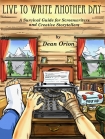Live To Write Another Day by Dean Orion (free ebooks for android .txt) 📕

Read free book «Live To Write Another Day by Dean Orion (free ebooks for android .txt) 📕» - read online or download for free at americanlibrarybooks.com
- Author: Dean Orion
Read book online «Live To Write Another Day by Dean Orion (free ebooks for android .txt) 📕». Author - Dean Orion
On the other hand, when you watch a movie or a TV show or read a novel, you can easily become deeply emotional. That’s because the experience is entirely passive. You’re focused on receiving information, with no need to achieve anything. The dominant feeling is one of empathy for the characters you see on the screen or for whom you’re reading about. This reaction is utterly visceral because storytelling is an archetypal ritual, one our ancestors have engaged in for thousands of years, predisposing us to respond in this way.
So, if the two experiences do indeed affect us in fundamentally different physiological ways, then how could we possibly expect them to elicit similar feelings or emotions? And should they? Do video games really need to be more like movies, and do all stories need to be deeply emotional in order to be good? I don’t think so. You don’t have to look any further than the perennial success of high-tech spy novels, like those popularized by Tom Clancy, and procedural TV crime dramas, like CSI and Law & Order, to answer that question.
Now, could I be convinced otherwise that playing a video game can be a deeply empathic and emotional experience? Given the rapid advancement of technology, and the possibilities that will undoubtedly emerge in the future, absolutely. I believe anything is possible.
Narrative and Interactive Design
When it comes to narrative storytelling, there’s no question a prominent seat at the table exists not just for video games, but for many other types of interactive experiences as well. The challenge is that virtually all of our previous narrative formats have evolved out of the oral tradition. While a narrative wants to be linear and set in stone, interactive design is pretty much the opposite. It wants to be non-linear and allow the user some degree of autonomy as to how they consume the experience.
What you have in many video games is a lot of narrative delivered through backstory. In other words, you’re free to explore the world the game designers have created, solve puzzles, and/or perform missions that can be completed in multiple ways. As a result, you uncover the story of events that happened in the past. I really like games that do this effectively, where the more you play, the more you learn and understand about how this particular world came to be.
Most video games also deliver narrative through the use of what are commonly called cutscenes or cinematics, which are essentially a sequence of movie scenes shoe-horned between the missions. When the game is completed, these scenes collectively tell the entire story. Personally, I have never found this method to be very satisfying because it usually takes control away from the player (i.e., stops the game) so that (A) the scenes can play at a higher resolution, and/or (B) the player is less likely to miss critical parts of the narrative. If cinematics are part of the design, I prefer them to run in game, which means the narrative is delivered on the fly during play. You may have to sacrifice a bit of the visual aesthetic, and you do risk having some story beats go unseen, but some of that can be made up for with clever design. At least this way the story feels more organic, since the active part of the experience isn’t interrupted for the sake of delivering the passive part, which can be frustrating at times.
Another approach to creating interactive narrative that I have always been a big fan of involves the use of “branching” story architecture. This means multiple versions of a single over-arching story can be experienced by presenting the player with a number of different story pathways, each of which is determined, at least in part, by the choices the player makes along the way. In some cases, all paths lead to the same conclusion. In other cases, the structure provides for more than one possible outcome, which then allows players to replay the game and have a different experience.
On a practical level, creating something of this breadth is clearly an enormous amount of work. It’s also an incredible writing and interactive design challenge, because not only do you have to structure and execute a single linear story (which is tough enough to do well), you also have to create a tremendous number of alternative scenes as well as somehow find a way to bring each story path to its logical and inevitable conclusion.
How About a Little More Character?
One area of narrative game design that presents a wealth of potential opportunities is the area of character. As we discussed earlier, characters and their motivations are the fundamental drivers of stories. Yet in most narrative-based games, the wants and desires of characters are often incidental to the actions that the player is required to make in order to progress through the experience. So the question that I’ve been asking for years is:
Why can’t character motivation be more of an integral part of gameplay?
Here’s an example. I’m a big World War II buff, so the early Call of Duty games were among my favorites, Call of Duty 2: Big Red One in particular. This type of game is generally called a





Comments (0)